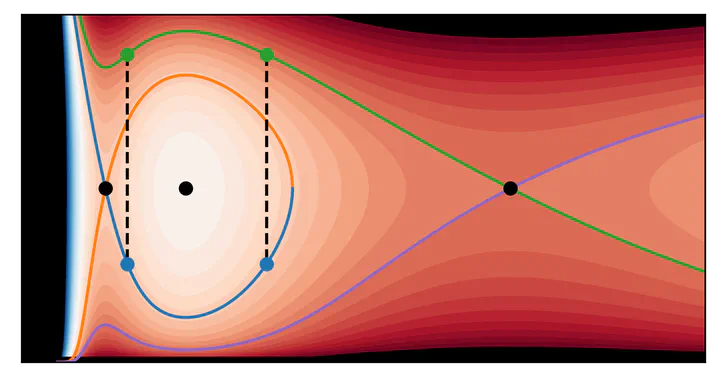Black Hole Accretion Disks
 Perturbation theory predicts three possible steady black hole accretion profiles. Which one does nature choose?
Perturbation theory predicts three possible steady black hole accretion profiles. Which one does nature choose?Black holes often form accretion disks — swirling clouds of gas that rapidly fall into the black hole. As the gas speeds up, it transitions from sub to supersonic flow. Much as with the Concorde, this transition can lead to transonic shocks, where the gas abruptly slows down as it piles into itself. We want to know whether shocks like this could arise, and how they could illuminate other properties of black holes and accretion disks.
The key to understanding shock waves is their multi-scale behaviour. Throughout most of the flow, we can neglect viscosity and consider the gas as an ideal fluid (as in the green and blue profiles in the featured figure). But this changes at the shock (black vertical lines), where even infinitesimal dissipation can cause a rapid change in behaviour of the whole system. Previous analysis skipped over the precise details of shock, setting the thickness to zero. But, as with much of mathematics, the limiting process matters!
Singular perturbation theory solves these problems by decomposing them into large and small scales, before unifying them through asymptotic matching. One such method, multiple scales matched asymptotics, is extremely versatile, and was the key mathematical tool I used to design better volume penalty and phase field methods. But what matched asymptotics gain in flexibility, they lose in rigour. It is often difficult to know when the approximations remain valid. This is where Geometric Singular Perturbation Theory (GSPT) excels — actually giving ironclad proofs of asymptotic behaviour.
Coming back to black holes, what is so interesting about accretion disks is that standard methods predict up to three possible configurations, with a steady outer shock, a steady inner shock, or no shock at all! By combining the flexibility of multiple scales matched asymptotics, and the rigor of GSPT, we can revisit classical models of black hole shocks, and resolve the degeneracy. We derive explicit formulae for shock wave stability, and show that both the outer shock and smooth profile are possible solutions. The growth/decay rates differ from the purely inviscid analysis, and the first order corrections grow extremely large, thwarting numerical validations and suggesting that even ostensibly stable shocks may be unlikely.